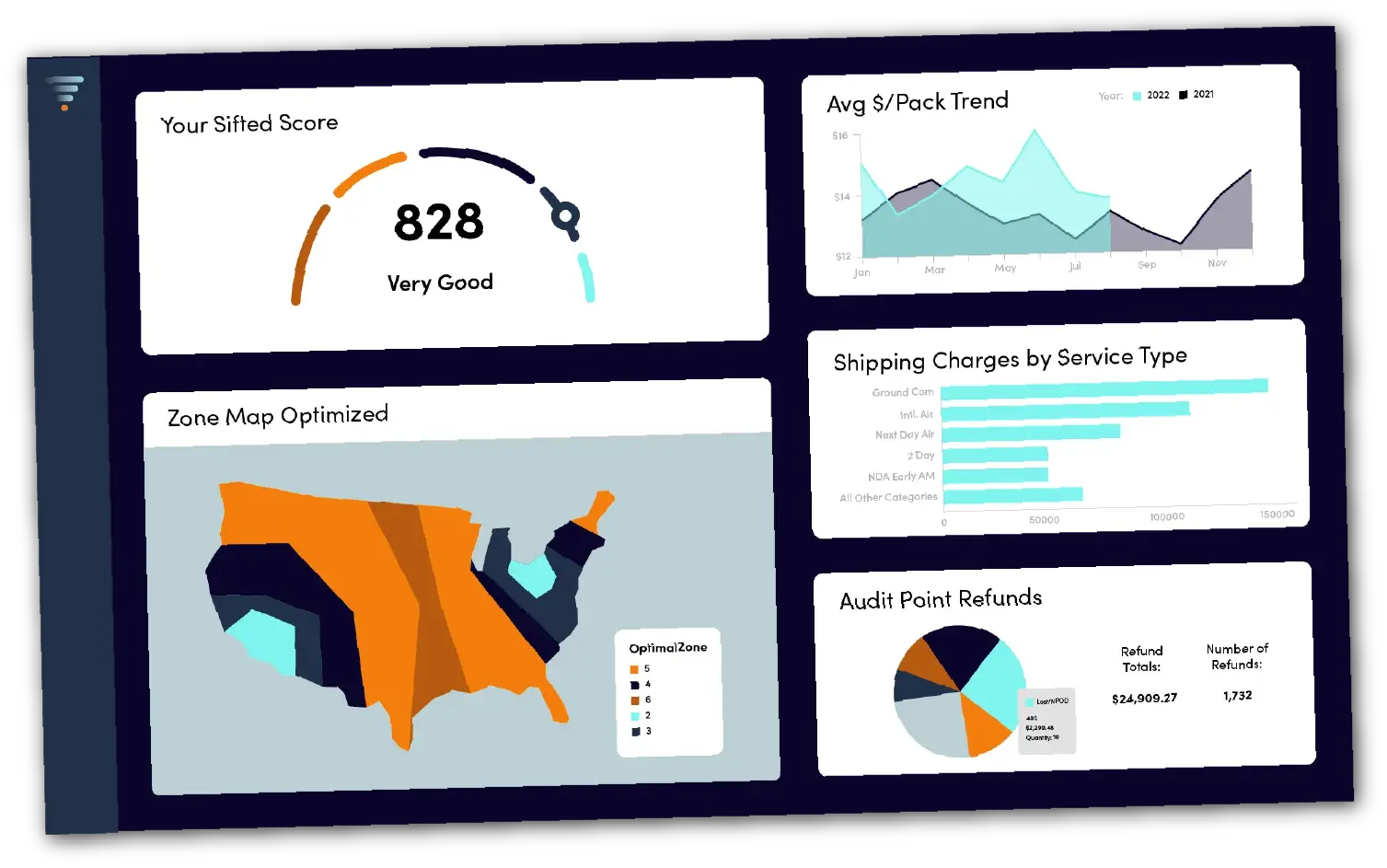Last mile delivery has never been more important to businesses. In 2023, the global last mile delivery market was valued at roughly $79.9 billion USD, and that’s expected to grow by 8.1% annually through 2030.
As last mile shipping grows, so will businesses’ dependence on their parcel carriers, which means using a single carrier isn’t a sustainable option for most. Shippers have already felt the pain of single sourcing through volume caps, strike fears, and record-high rate increases.
Meanwhile, there are more alternatives to the FedEx/UPS duopoly than ever. Regional carriers like OnTrac are expanding their service area to reach both coasts, and eCommerce-giant Amazon has launched Amazon Shipping, a service closely resembling FedEx and UPS’ offerings.
Shipping with a mix of carriers allows for greater flexibility, along with other benefits like cost savings or performance improvements.
However, many shippers don’t know where to start and are left asking themselves questions like:
- What should I look for in a carrier?
- How can I shift volume without tanking my relationship with my current carrier?
- How do I know a carrier’s proposal will save me money?
We’re here to answer those questions by walking you through the three phases of carrier diversification:
- The prep work
- The carrier search
- Maximizing results
At the end, we’ll explore some real-world diversification stories that show how this plan can play out.
Let’s get started.
The Prep Work
Why Diversify?
Before you embark on your diversification journey, have a destination in mind. There are three major objectives when growing your carrier mix:
- Risk Reduction
By partnering with multiple carriers, you reduce your dependence on a single provider, ensuring that labor issues and capacity constraints won’t bring your entire shipping process to a standstill. It also safeguards your company’s reputation. - Client Experience
Faster delivery makes for a better client experience, so search for a carrier that can shorten your average transit times. There are a number of ways to do this: more favorable Express rates with one carrier, a regional carrier serving the area, etc. - Cost Savings
Despite what some shippers think, adding carriers can actually lower your shipping costs – if you do it right. You can earn favorable rates for specific segments of shipments while balancing discount tiers. (This isn’t about getting carriers into a “bidding war,” but instead employing a strategic, data-backed negotiation strategy.)
Achieving two of these three goals is the litmus test for a successful negotiation. It’s possible to achieve all three – and that’s a home run.
Gauge Your Shipping Health
Once you’ve identified your goals, define and measure your key performance indicators (KPIs).
Important KPIs to look at:
- Average shipping zone
- Average price per package
- Average transit days
- On-time delivery performance
- Service mix by zone or state
- Accessorial breakdown
- Shipping volume relative to discount tiers
Analyzing your parcel invoice data can show which of these KPIs need improvement, and might reaffirm or redefine how you view the three diversification goals (risk reduction, client experience, and cost savings). By tracking them before and after adding to your mix, you can showcase the ROI and improvements you’ve made.
Finding and accurately measuring these may seem like a daunting task if you don’t have the right tools. A software solution like Sifted Logistics Intelligence can effortlessly ingest your parcel data to display (and help monitor) all of these metrics for you.

The #1 Logistics Intelligence Software
Know Your Network
Geography is a key factor to consider when looking for new carriers – and optimizing your parcel operations as a whole.
If your average shipping zone is 5 or above, your distribution network is inefficient in reaching your clientele. In this scenario, consider:
- Adding new distribution centers
- Or incorporating a 3PL to achieve the same result without having to build your own facility
- Zone-skipping through an LTL service
- Finding a carrier that might offer discounts on those higher zones
Analyze historical ZIP Code data to find the regions and states you’re shipping to most frequently. This can illuminate the best locations for a new warehouse or warehousing 3PL, as well as show which regional carriers could be viable partners.
Knowledge of carriers’ networks is important too. If you find a regional carrier has a major distribution hub near one of your warehouses, there’s a great chance they can provide faster shipping speeds than a national carrier would in the same coverage area.
If you’re helping drive your organization’s sustainability goals, network optimization can play a huge role! A diversified, optimized network will lower your carbon footprint by putting products closer to their end destinations, as well as reduce your reliance on high-emission Express air shipping. Regional carriers can also be more sustainable, because they keep packages within a region, rather than going to a national hub only to return to the area.
Segment Your Shipments
The next step of prep work will be getting a 360-degree view of your shipping profile. You need a grasp on your different kinds of shipments such as:
- Most commonly used services/service types
- Most commonly shipped-to states/regions
- Shipment totals across different weight ranges
Below is an example of what this could look like, based upon weight breaks commonly used by carriers. This is a basic starting point. Adding service types, zones, and even states/regions can help narrow down your view of your package segments even further.
| Packages | Gross Amount | |
|---|---|---|
| Ground Residential | 121,392 | $2,398,686 |
| 1-10 lbs | 81,364 | $1,311,588 |
| 11-20 lbs | 35,312 | $878,209 |
| 21-30 lbs | 3,976 | $157,092 |
| 31-50 lbs | 153 | $7,696 |
| 51 lbs+ | 587 | $44,101 |
| Ground Commercial | 9,448 | $171,322 |
| 1-10 lbs | 6,089 | $92,066 |
| 11-20 lbs | 3,020 | P$60,762 |
| 21-30 lbs | 106 | $3,193 |
| 31-50 lbs | 35 | $1,415 |
| 51 lbs+ | 198 | $13,886 |
| Express | 1,418 | $42,759 |
| 2 Day | 564 | $17,146 |
| 3 Day | 798 | $21,809 |
| Overnight | 56 | $3,804 |
| Total | 132,258 | $2,612,767 |
By presenting carriers these segments when negotiating, you can learn which are (or aren’t) attractive to them. This allows you to strategize what shipments to peel away from your current carrier(s), and create “swimlanes” to ensure certain types of shipments are sent through the best carrier and service for them.
Additionally, segmenting can help you estimate how much volume you’ll be taking away from your carrier. Losing discounts because of lower volumes with a specific carrier is the most common fear shippers have when diversifying. More likely than not, you’re going to drop a discount tier. However, if you get better rates from the new carrier in return, you can lower your costs at the end of the day.
A number of market factors impact what certain carriers favor, but here’s a high-level overview of how the carriers stack up:
| Carrier | Strengths | Weaknesses |
|---|---|---|
UPS | Up to 150 lbs, Express & Ground services, serves all 50 states and consistent deliveries | Penalizes heavy shipments |
FedEx | Up to 150 lbs, Express & Ground services and serves all 50 states | Penalizes heavy shipments and inconsistent deliveries |
| Amazon | Up to 150 lbs, serves contiguous U.S., doesn’t penalize heavy shipments, no residential surcharge and very competitive discounts | No express services and pickup currently only offered in 15 metro markets |
| USPS | Up to 70 lbs, serves all 50 states, less accessorial fees, no delivery-area or residential surcharges | Poor delivery speed and doesn’t offer discounts |
| OnTrac | Competitive transit times, reaches 85% of U.S. population and planning 2024 midwest expansion | Only reaches 35 states and doesn’t ship above 50 lbs |
| Pitney Bowes | Serves all 50 states and offers per-ounce pricing for ultra-light packages | Only competitively prices for shipments up to 5 lbs and only ships from 27 states |
The Carrier Search
Finding your new carrier(s)
You’ve done the prep work. You know where you stand with your current carrier(s), and what you’re looking for in an additional partner. It’s time to get out there and negotiate!
Even if you know which carrier you want to work with, it’s a good idea to send an RFP to others. Opening that conversation means you’ll have a relationship if you need to expand further in the future.
They might surprise you with their aggressive bidding.
When you send out RFPs, there are two approaches:
- Share your entire profile. You can then analyze their proposal to find which segments they’re most aggressively pricing, and only ship those segments with them.
- Pre-specify which segments you want them to bid on. This one tends to work better. Choose segments that aren’t optimal with your current carrier. These could be shipment weights without favorable pricing, service types you don’t get discounts for, shipments to geographic regions your carrier performs poorly in, etc.
When presented with your whole profile of shipments, carriers tend to want it all, meaning their discounts and concessions will be spread out across segments. By clearly specifying what you’re willing to give them, they’re more likely to offer aggressive discounts to win that volume.
It’s important to know exactly how much a new carrier agreement might save (or cost) you. By uploading contract proposals to Sifted’s Rate Simulation tool, you can see exactly how new rates and discounts stack up to your shipping profile based on last year’s shipments.
LeaderShipping Ep. 4: Mastering the Art of Carrier Negotiations
Maximizing Results
Congrats, your RFP was successful, a contract’s been signed, and you’re onboarded with your new carrier! (We make it sound so easy, right? :))
Now what?
Adding diversity to your mix inherently adds complexity. There’s no way around it. Navigating this complexity can make or break your success. Follow these steps to come out on top:
Follow your Swimlanes
You’ve created swimlanes for your carriers. Now, make sure you follow them.
If you’ve only used one carrier before, you might have been managing all shipments through their own software, such as UPS Worldship or FedEx Delivery Manager. Unfortunately, those won’t cut it anymore.
Find a Transportation Management System (TMS) that allows you to create routing rules to ensure each shipment follows the proper swimlanes. This may require training for your warehouse staff.
Collect and Monitor Data
How are you collecting data from your carriers? Now that data is coming in from multiple/more sources, you’ll need a tool that can aggregate it all in one place, giving you a single source of truth for your parcel operations.
Sifted Logistics Intelligence can aggregate and illuminate data from FedEx, UPS, the USPS, Amazon, DHL, Pitney Bowes, OnTrac, and a number of LTL carriers.
Balance Volumes
Volumes fluctuate, and keeping an eye on your 52-week rolling average with each carrier is crucial to avoiding surprise drops in tiers. This could show an opportunity to shift more volume to a new carrier, like in the example below (we also covered this in our Carrier Diversification presentation at PARCEL Forum). If you have enough wiggle room within a tier with carrier A, and have smaller volume commitments to carrier B, you could potentially move up multiple tiers with carrier B without dropping with A.
At the end of the day, communicating with your carrier reps is a necessity. If you plan to shift volumes, communicate that ahead of time. It opens dialogue for how each of you can offer more value to the other
Similarly, if you anticipate capacity crunches with one, communicate that to another ahead of time to ensure they can handle your new volume.
Remember, your carrier reps are your allies.
PARCEL Forum Carrier Diversification Presentation
Real-World Diversification Stories
Diversification success stories:
So what does all this look like in action?
Success Story 1 – Woodworking Manufacturer
A manufacturer of woodworking tools entered 2023 relying solely on UPS for 170k annual packages. As Teamsters strike threats grew, they realized they needed to find a second carrier – and fast.
They went to FedEx and requested a proposal for all of their segments.
With the help of Sifted’s software, they analyzed FedEx’s proposal to find their most aggressive pricing. With these insights, they knew their best strategy would be to send all ground and next-day shipments with FedEx, and keep everything else with UPS.
This change caused them to drop two volume tiers with UPS. While they lost some discounts with them, the lower cost-per-package for the FedEx segments were net positive.
The Results? In 12 months following diversification:
- Average monthly shipping costs were down over $13,000
- Average cost per package dropped from $17.07 to $14.39
- Meanwhile, monthly volumes rose roughly 1,000 packages
- Shipping more and spending less is a winning combination!
- Saved $579k total – a 54% discount compared to what their spend would’ve been with just UPS
- Saved themselves a lot of stress amid strike threats
Success Story 2 – eCommerce Retailer
Our second success story comes from an eCommerce retailer that was also only using UPS. They were spending $35 million annually on shipping and knew opportunities for savings existed – particularly within a division of their business that shipped very lightweight packages.
With a segment already in mind, Sifted helped them find that peeling away ~630k of their lightest packages from UPS wouldn’t drop them a volume tier.
Then, they went shopping – sending the data on the segment to several carriers for proposals.
Pitney Bowes was the lowest bidder. Their proposal included a higher base rate than what UPS was charging, but a lower fuel surcharge, and most notably, no Delivery Area Surcharge for residential shipments. Sifted’s software combed through the proposal’s details and found that even with a higher base rate, the proposal would lower their costs.
The Results?
- Moved ~630k monthly packages to Pitney Bowes – roughly 16% of their total volume
- Saved over $235k on shipping for those segments to date
The Carrier Portfolios of the Future
The benefits, and necessity, of a diverse carrier mix become clearer with each passing year. Decades ago, LTL shippers could rely on one carrier. Today, that would seem crazy.
Parcel shipping is moving in the same direction. If you don’t start diversifying soon, you’ll be left behind.
Abandoning the status quo can be uncomfortable, but savvy shippers can navigate the carrier market with ease if they follow the right steps.
Data is the key. A software solution like Sifted Logistics Intelligence can be your guiding light through the whole process. Finding pain points in your shipping profile and segmenting your shipments for different carriers equips you with the data for negotiating. After each negotiation, Sifted’s always-on monitoring tracks carrier rate compliance, where you stand in your volume tiers, and how your savings stack up to provide ongoing optimization and peace of mind.
See a personalized demo of Sifted.












